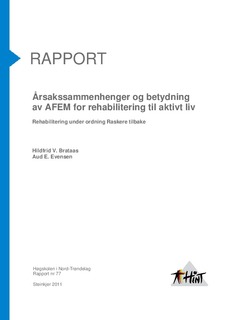| dc.description.abstract | At the beginning of the 20th century, new measures have been implemented to promote more
return to work after sick leave and decrease the number of people who are dependent on
social security as the source of income. In co-operation between the Directorate of Health and
Welfare, the "Faster back to work scheme" was created. It was carried into effect by the
Absence due to Sickness Commission in 2006. Under this Faster back scheme, specialist
health services, the Central Norway Regional Health R & D, Health Mid-Norway, have
entered into agreements with private rehabilitation centers. The purpose is to expand capacity
and to create and evaluate new rehabilitation models under the scheme. At a private
rehabilitation institution in Central Norway, Smednes trivselsgård as, a new model of AFEM
rehabilitation is developed. AFEM stands for “Responsibility For Self-Mastery”. The model
has a psychosocial and educational focus and includes a four-week rehabilitation stay with
follow-up counseling over a year when needed. | en_US |
